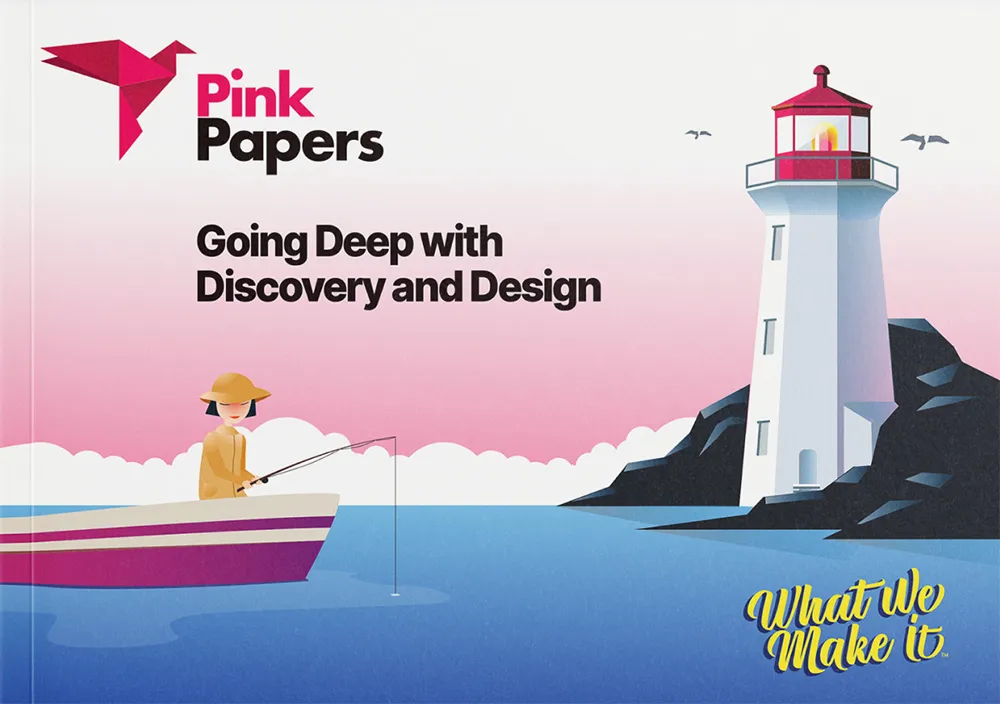Going Deep with Discovery and Design
At What We Make It, we like to go deep with our discovery and design processes. Our take on human-centered design includes human-powered analysis and considers the whole user, their position within broader interconnected systems, their individuality and diversity, their barriers and challenges. Additionally, our discovery and design methods are participatory, we involve users every step of the way to make sure we get it right.
In this WWMI Pink Paper we share our approaches to going deep with users in discovery and design, and how these generate comprehensive insights into users and their experiences and lead to truly human-centered service design.
Surface Discovery
Discovery that stays on the surface is not without value, but the insights it can generate will only go so far. On the surface, we can easily observe users’ demographics and behaviour. We can segment them into personas, ask them their needs, and chart their journeys through any given digital service. For simple projects with a consistent user base, this can sometimes suffice to design a digital service that will do what it needs to.
Discovery that stays on the surface is typically not conducted in a systematic way. It is usually based on small samples of users and relies too heavily on assumptions or internal opinions about user backgrounds and preferences. This can result in the production of data that is inconsistent, and insights typically biased towards the assumptions of the designers, with no reliable means to validate findings.
Below the Surface
Below the surface are users’ motivations, desires, quirks, fears, anxieties, and day-to-day realities. Here we can find the individual factors in a user’s personality; we can gain a deeper understanding of their preferences, intended purpose for using a digital service as well as their economic means for engaging with said service. Put simply, the methods used for discovery that go below the surface are largely qualitative and participatory. Insights cannot be gleaned from survey results alone and require contextual probing.
When investigating below the surface, users come to the table with service designers to collaborate and generate ideas, explore design concepts together, and co-design solutions. Here we encourage participants to contribute their perspectives, insights, and creative ideas. Below the surface, we can foster a sense of ownership and involvement in the research process. This not only enriches the research process but also ensures that the resulting designs and solutions are more aligned with the needs, preferences, and aspirations of different user communities.
A Little Deeper
Discovery and design that goes a little deeper focuses on users that face barriers to access a digital public service, considers the equity implications, and seeks opportunities to remove the barriers within the design itself. When we go a little deeper, we utilize a Gender-Based Analysis Plus (GBA+) framework in planning, data collection and analysis, and design recommendations. Our sampling procedures are more deliberate, and must be representative of those who are typically excluded.
When we go a little deeper, we consider the intersectionality of sex and gender, age, racial diversity, neurodiversity, and socio-economic status, and the impacts these things can have on the user experience. This type of analysis aims to identify potential disparities among users based on language, cultural norms, literacy, technology access, biases, trust, and opportunities for improvement within the user experience.
Way Down Deep
When we go way down deep, this is where we look at the broader systems which the digital service is interacting with. We do this by integrating elements of systems theory, which is an interdisciplinary approach that focuses on understanding and analyzing complex systems made up of interconnected and interdependent components. This approach situates the user, and the product or service being developed, within the context of the socio-political, economic, and technological systems in which they are currently operating.
Discovery and design that go way down deep factors in the wider digital ecosystem that the product or service operates within and interacts with. By considering factors such as the norms and realities users are experiencing in social and cultural systems, researchers gain a more comprehensive understanding of how users interact with products and services in the real world. This broader perspective enables the design of solutions that are tailored to specific contexts, increasing the likelihood of successful adoption and engagement across identity and socio-economic groups. This forward-thinking approach contributes to the long-term viability and relevance of the products and services being developed.



